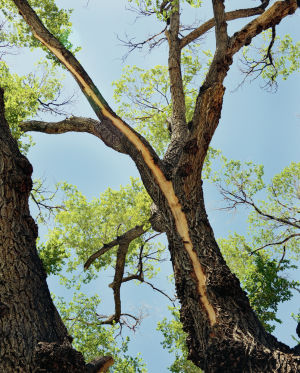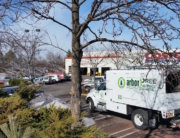NOTE: This copy was taken from the Texas A & M Department of Ecosystem Science and Management Department
Wayne K. Clatterbuck, Associate Professor Forestry, Wildlife & Fisheries University of Tennessee, David S. Vandergriff, UT Extension Urban Horticulture & Forestry, Kim D. Coder Professor, Silvics/Ecology Warnell School of Forest Resources The University of Georgia
Lightning is one of nature’s most powerful forces and can cause significant tree damage. Lightning can have devastating effects on people, property and trees. Each strike of lightning can reach more than five miles in length, and produce temperatures greater than 50,000 degrees Fahrenheit and an electrical charge of 100 million volts. At any given moment, there are 1,800 thunderstorms in progress somewhere across the earth. Lightning detection systems in the United States sense an average of 25 million lightning strikes per year.
Trees occupy a particularly susceptible position in the landscape, since they are often the tallest objects. Tall trees are the most vulnerable, especially those growing alone in open areas such as on hills, in pastures or near water. Many of these trees line our community streets and surround our homes, schools and businesses.
Response of Trees to Lightning
A tree’s biological functions and/or structural integrity are affected by lightning strikes. Along the path of the strike, sap boils, steam is generated and cells explode in the wood, leading to strips of wood and bark peeling or being blown off the tree. If only one side of the tree shows evidence of a lightning strike, the chances of the tree surviving and eventually closing the wound are good. However, when the strike completely passes through the tree trunk, with splintered bark and exploded wood on each side, trees are usually killed.
Many trees are severely injured internally or below- ground by lightning despite the absence of visible, external symptoms. Lightning or electrical current passes from the trunk of the tree through the roots and dissipates in the ground. Major root and tree damage from electricity may cause the tree to decline and die without significant above ground damage. If the tree is in leaf, the leaves wilt and the tree will probably die within a few days. If the tree survives long enough to leaf out the following spring, then the chances of recovery are much greater. Watering and fertilization are suggested to reduce tree stress.
Generally, when lightning damage has created hazardous broken branches, corrective pruning should be done. However, waiting two to six months is recommended before doing major and expensive corrective pruning to assess whether the tree will recover. If during this waiting period, the tree shows no obvious signs of decline, then the pruning is probably worth the expense. Consult with a certified arborist for recommendations concerning the health of your damaged tree. Commonly prescribed practices are water management, bark repair, pruning, fertilization, pest management and tree monitoring. Expensive treatments should not be taken until the tree appears to be making a recovery. Otherwise, when it becomes obvious that the tree will not recover from the lightning strike, the tree should be removed.
Lightning Protection Systems for Trees
Historic, rare, and specimen trees, especially when they are the center of landscapes or they shade or frame recreational areas, are valuable and can be protected by a properly installed lightning protection system. Trees with special significance, or that people or animals might move under in a storm, should be protected. Trees closer than 25 feet from a building or structure should also be protected to minimize “side-flash.” Parks, golf courses, and public buildings should have large or important trees protected to minimize liability risks.
Tree lightning protection is expensive in labor and materials. Lightning protection systems must be installed properly with correct materials to insure long-term protection. For example, aluminum should not be used for any link in a system, nor should solid wire of any type be used. It is essential to consult with a trained arborist or urban forester, and a lightning protection system installer before designing a protection system for a tree.
Lightning protection systems in trees do not attract lightning. The purpose of a protection system is to dilute and slowly release electrical charge potential between the ground and cloud. Trees are not good conductors of electricity but can act as a better conduit than air. Protection systems dissipate the electrical charge before it can build to high levels.
Summary
Lightning damage in trees is much more effectively prevented than repaired and is often less costly. Qualified arborists can recommend the installation of lightning protection systems where appropriate or the proper course of action if a tree has been struck by lightning.
Sources
Coder, K.D. 2004. Lightning damage in trees: the spark of death. Arborist News 13(3):35–43.
Curran, E.B., R.L. Holle and R.E. Lopez. 1997. Lightning fatalities, injuries and damage reports in the United States from 1959-1994. National Oceanic & Atmospheric Administration (NOAA) Technical Memorandum NWS SR-193. U.S. Department of Commerce, National Weather Service, Scientific Services Division, Southern Region, Fort Worth, TX. (www.nssl.noaa.gov/papers/techmemos/NWS-SR-193/techmemosr193.html)
Howland, R. 2003. A striking danger in trees. Tree Care Indus- try 14(5):40–42. National Arborist Association, Inc. 2001. American National Standard for Tree Care Operations, ANSI Z133.1. Manchester, NH. 31 p. National Arborist Association, Inc. 2002.
Lightning Protection Systems, ANSI A300, Part 4. American National Standard for Tree Care Operations – Tree, Shrub, and other Woody Plant Maintenance – Standard Practices Manchester, NH. 9 p.
National Fire Protection Association. 2004. Installation of lightning protection systems. Publication NFPA 780. Quincy, MA. 50 p. (www.nfpa.org)
Smiley, E.T., A.W. Graham, Jr., and S. Cullen. 2002. Lightning Protection Systems. Best Management Practices Series. International Society of Arboriculture, Champaign, IL. 40 p.
U.S. Department of Commerce, National Oceanic & Atmospheric Administration, National Weather Service. 2005. Lightning Safety Outdoors. (www.lightningsafety.noaa.gov/outdoors.html) and (www.noaa.gov/lightning.html)







